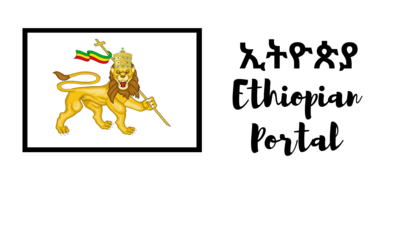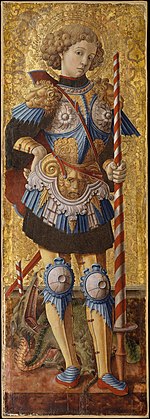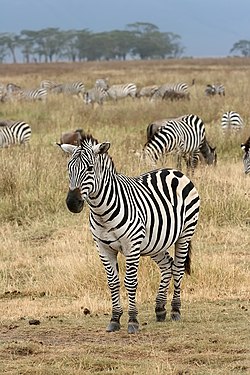Portal:Ethiopia
Introduction
Federal Democratic Republic of Ethiopia የኢትዮጵያ ፌደራላዊ ዴሞክራሲያዊ ሪፐብሊክ (Amharic) | |
|---|---|
| Anthem: ወደፊት ገስግሺ ፣ ውድ እናት ኢትዮጵያ (English: "March Forward, Dear Mother Ethiopia") | |
 | |
| ISO 3166 code | ET |
Ethiopia, officially the Federal Democratic Republic of Ethiopia, is a tropical country located in the Horn of Africa region of East Africa. It shares borders with Eritrea to the north, Djibouti to the northeast, Somalia to the Northeast, East and Southeast, Kenya to the South, South Sudan to the West, and Sudan to the Northwest. Ethiopia covers a land area of 1,112,000 square kilometres (472,000 sq. miles). , it is home to around 128 million inhabitants, making it the 13th-most populous country in the world, the 2nd-most populous in Africa after Nigeria, and the most populated landlocked country on Earth. The national capital and largest city, Addis Ababa, lies several kilometres west of the East African Rift that splits the country into the African and Somali tectonic plates.
Anatomically modern humans emerged from modern-day Ethiopia and set out for the Near East and elsewhere in the Middle Paleolithic period. Southwestern Ethiopia has been proposed as a possible homeland of the Afroasiatic language family. In 980 BC, the Kingdom of D'mt extended its realm over Eritrea and the northern region of Ethiopia, while the Kingdom of Aksum maintained a unified civilization in the region for 900 years. Christianity was embraced by the kingdom in 330, and Islam arrived by the first Hijra in 615. After the collapse of Aksum in 960, the Zagwe dynasty ruled the north-central parts of Ethiopia until being overthrown by Yekuno Amlak in 1270, inaugurating the Ethiopian Empire and the Solomonic dynasty, claimed descent from the biblical Solomon and Queen of Sheba under their son Menelik I. By the 14th century, the empire had grown in prestige through territorial expansion and fighting against adjacent territories; most notably, the Ethiopian–Adal War (1529–1543) contributed to fragmentation of the empire, which ultimately fell under a decentralization known as Zemene Mesafint in the mid-18th century. Emperor Tewodros II ended Zemene Mesafint at the beginning of his reign in 1855, marking the reunification and modernization of Ethiopia. (Full article...)
Selected article -

The 1922 regnal list of Ethiopia is an official regnal list used by the Ethiopian monarchy which names over 300 monarchs across six millennia. The list is partially inspired by older Ethiopian regnal lists and chronicles, but is notable for additional monarchs who ruled Nubia, which was known as Aethiopia in ancient times. Also included are various figures from Greek mythology and the Biblical canon who were known to be "Aethiopian", as well as figures who originated from Egyptian sources (Ancient Egyptian, Coptic and Arabic).
This list of monarchs was included in Charles Fernand Rey's book In the Country of the Blue Nile in 1927, and is the longest Ethiopian regnal list published in the Western world. It is the only known regnal list that attempts to provide a timeline of Ethiopian monarchs from the 46th century BC up to modern times without any gaps. However, earlier portions of the regnal list are pseudohistorical and were recent additions to Ethiopian tradition at the time the list was written. Despite claims by at least one Ethiopian court historian that the list dates back to ancient times, the list is more likely an early 20th century creation, possibly originally written by Alaqa Taye Gabra Mariam or Heruy Wolde Selassie. The earlier sections of the list are clearly inspired by the work of French historian Louis J. Morié, who published a two-volume history of "Ethiopia" (i.e. Nubia and Abyssinia) in 1904. His work drew on then-recent Egyptological research but attempted to combine this with the Biblical canon and writings by ancient Greek authors. This resulted in a pseudohistorical work that was more imaginative than scientific in its approach to Ethiopian history. (Full article...)Selected biography -
Shambel Abebe Bikila (Amharic: ሻምበል አበበ ቢቂላ; August 7, 1932 – October 25, 1973) was an Ethiopian marathon runner who was a back-to-back Olympic marathon champion. He was the first Ethiopian Olympic gold medalist, winning his first gold medal at the 1960 Summer Olympics in Rome while running barefoot. At the 1964 Tokyo Olympics, he won his second gold medal, making him the first athlete to successfully defend an Olympic marathon title. In both victories, he ran in world record time.
Born in Shewa, Abebe moved to Addis Ababa around 1952 and joined the 5th Infantry Regiment of the Ethiopian Imperial Guard, an elite infantry division that safeguarded the emperor of Ethiopia. Abebe served in the Kagnew Battalion during Korean War. (Full article...)General images -
Related portals
Geography
Countries
WikiProjects
Main WikiProject
Related WikiProjects
Africa • Countries • Eritrea • African military history task force
Things you can do
- Visit the Ethiopian Wikipedians' notice board.
- The noticeboard is the central forum for information and discussion on editing related to Ethiopia.
- Comment at the Ethiopian deletion sorting page.
- This page lists deletion discussions on topics relating to Ethiopia
Selected pictures
Did you know -

- ... that medieval Ethiopian kings claimed to be descended from Solomon?
- ... that Aguil Chut-Deng took 22 child refugees from South Sudan to Ethiopia during civil war so that they could attend school?
- ... that Tsadkan Gebretensae, one of the top commanders of Tigray forces in the conflict against the Ethiopian government, previously served as chief of staff of the Ethiopian National Defense Force?
- ... that the government of Ethiopia's SNNP Region supported local governments calling for a referendum to secede from the region?
- ... that Liberian paramount chief Tamba Taylor worked as a tailor and claimed to have sewn clothes for Ethiopian emperor Haile Selassie and Ghanaian president Kwame Nkrumah?
- ... that Quintin Johnstone advocated giving control of an American-governed law school to native Ethiopians?
In the news
Categories
Topics
Other Ethiopia-connected Wikipedias
Wikimedia
The following Wikimedia Foundation sister projects provide more on this subject:
-
Commons
Free media repository -
Wikibooks
Free textbooks and manuals -
Wikidata
Free knowledge base -
Wikinews
Free-content news -
Wikiquote
Collection of quotations -
Wikisource
Free-content library -
Wikiversity
Free learning tools -
Wikivoyage
Free travel guide -
Wiktionary
Dictionary and thesaurus
Other portals





































































